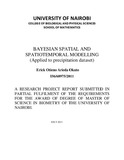| dc.description.abstract | The daily rainfall data is one type of data that is not easy to fit a simple model. This is due to the fact that there may be several days when it rains and it doesn't rain in other days.
Besides, this special feature of rainfall, it has spatial dependence which complicates its
predictions under the classical paradigm. In addition, if the daily amount of rainfall is taken over time say one year or so together with appropriately chosen covariates, temporal effects may also affect the reliability of prediction rule. Furthermore, we may need the average amount of rainfall on a particular day at given sites where we have ongoing experiments with unknown amount of rainfall. We propose to fit a semi-continuous model using Bayesian method and take advantage of Stochastic Partial Differential Equation (SPDE) approach as provided in the Integrated Nested Laplace Approximation (INLA).
Due to scares resources, we may not be able to observe the amount or rainfall recorded
within the entire statistical population. Sampled data can therefore be obtained from such sources including satellite images and weather stations. Irrespective of the data source, we need to determine with certainty; the average daily rainfall at specified points for the days of interest, distribution of rainfall within and outside the practical range over time and if possible interpolate and extrapolate taking into account effects of the available covariates, spatial dependence and temporal effects.
Surely, this problem is beyond classical interpolation methods like simple or ordinary
kriging where; trend surface function is constant, variogram is constant in the whole area of interest and the target variable is assumed to follow approximately Gaussian
distribution which at least is untrue in this case.
Since, we always try to go for the most flexible, most comprehensive and the most robust technique, we have adopted a Bayesian method in this work. Both covariates and random effects will be treated as random. We know that covariates are fixed effects; therefore the randomness here is on the uncertainty about their true values. We will create two outcome variables; one for the occurrence of rainfall and the other for the amount of rainfall. The occurrence which depict either success or failure probability will be assume a binomial likelihood while the amount which is strictly positive will assume a gamma likelihood. On the other hand, fixed effects which include elevation and distance from the sea will assume NeD, 0.001) where 0.001 is the precision parameter equivalent to variance of 1000 while the random effects; that is temporal effects will assume an autoregressive process of order one (ar1) and the spatial dependence will assume stochastic partial differential equation (SPDE). Due to the challenges that MCMC schemes have faced over the years, that is convergence and running time, we adopt the Bayesian technique using numerical methods as given by the Integrated Nested Laplace | en |

